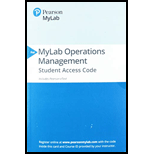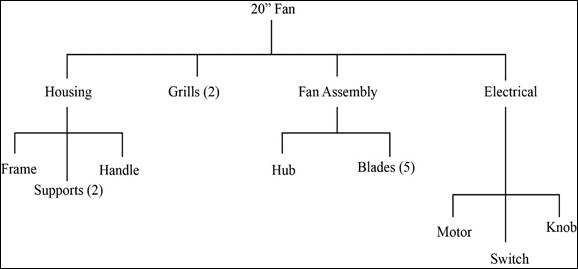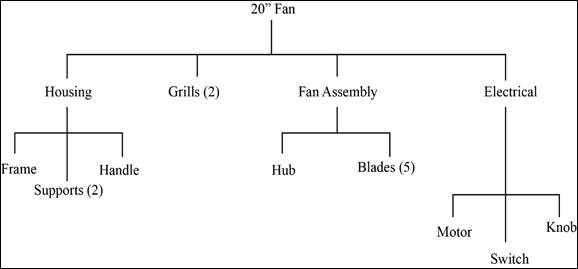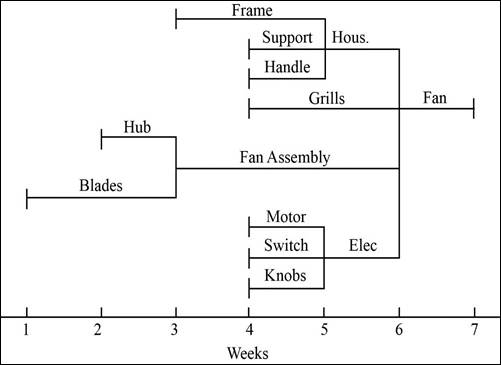
Concept explainers
a)
To construct: A product structure.
Introduction:
Product structure:
The product structure is a visual representation of the components needed for a product assembly and the sequence at which they must be developed. It will clearly depict the parents and children components at each level.
a)
Answer to Problem 13P
Product structure:

Explanation of Solution
Given information:
- 1000 20” fans due in week 7.
- Each fan is made of a housing assembly, two grills, fan assembly and an electrical unit.
- Housing assembly is made of frame, two supports, and a handle.
- Fan assembly is made up of a hub and five blades.
- Electrical unit consists of a motor, switch and a knob.
| Component | Lead time | On-hand inventory | Lot size |
|
| 20" Fan | 1 | 100 | ||
| Housing | 1 | 100 | ||
| Frame | 2 | |||
| Supports (2) | 1 | 50 | 100 | |
| Handle | 1 | 400 | 500 | |
| Grills (2) | 2 | 200 | 500 | |
| Fan assembly | 3 | 150 | ||
| Hub | 1 | |||
| Blades (5) | 2 | 100 | ||
| Electrical unit | 1 | |||
| Motor | 1 | |||
| Switch | 1 | 20 | 12 | |
| Knob | 1 | 25 | 200 in week 2 |
Product structure:

The product is a 20” fan. It is made of four components. Each fan is made of a housing assembly, two grills, fan assembly and an electrical unit. Housing assembly is made of frame, two supports, and a handle. Fan assembly is made up of a hub and five blades. Electrical unit consists of a motor, switch and a knob.
b)
To construct: A time-phased product structure.
Introduction:
Time-phased product structure:
The time-phased product structure will represent the product visually with the details of when each component must begin production. It should be done to ensure that all the components are on time.
b)
Answer to Problem 13P
Time-phased product structure:

Explanation of Solution
Given information:
- 1000 20” fans due in week 7.
- Each fan is made of a housing assembly, two grills, fan assembly and an electrical unit.
- Housing assembly is made of frame, two supports, and a handle.
- Fan assembly is made up of a hub and five blades.
- Electrical unit consists of a motor, switch and a knob.
| Component | Lead time | On-hand inventory | Lot size | Scheduled receipt |
| 20" Fan | 1 | 100 | ||
| Housing | 1 | 100 | ||
| Frame | 2 | |||
| Supports (2) | 1 | 50 | 100 | |
| Handle | 1 | 400 | 500 | |
| Grills (2) | 2 | 200 | 500 | |
| Fan assembly | 3 | 150 | ||
| Hub | 1 | |||
| Blades (5) | 2 | 100 | ||
| Electrical unit | 1 | |||
| Motor | 1 | |||
| Switch | 1 | 20 | 12 | |
| Knob | 1 | 25 | 200 in week 2 |
Time-phased product structure:

The end product is the fan which must be ready at week 7. All the other components must be completed on week 6. The components at the lower level must be completed first before proceeding to the higher levels. Each component at each level is begun depending on the lead time of the product.
The products are started in advance so that they are developed and ready on time so that the dependent parent will be ready to develop its product. The process is repeated until all the subassemblies are ready to make the final product.
c)
To develop: A net requirements plan.
Introduction:
Net requirements plan:
The net requirements plan is the plan which is established on the gross requirements plan formed by deducting the stock on and the scheduled receipts. If the total requirement is below the safety stock levels, a planned order is made based on the given lot sizing technique.
c)
Explanation of Solution
Given information:
- 1000 20” fans due in week 7.
- Each fan is made of a housing assembly, two grills, fan assembly and an electrical unit.
- Housing assembly is made of frame, two supports, and a handle.
- Fan assembly is made up of a hub and five blades.
- Electrical unit consists of a motor, switch and a knob.
| Component | Lead time | On-hand inventory | Lot size | Scheduled receipt |
| 20" Fan | 1 | 100 | ||
| Housing | 1 | 100 | ||
| Frame | 2 | |||
| Supports (2) | 1 | 50 | 100 | |
| Handle | 1 | 400 | 500 | |
| Grills (2) | 2 | 200 | 500 | |
| Fan assembly | 3 | 150 | ||
| Hub | 1 | |||
| Blades (5) | 2 | 100 | ||
| Electrical unit | 1 | |||
| Motor | 1 | |||
| Switch | 1 | 20 | 12 | |
| Knob | 1 | 25 | 200 in week 2 |
Net requirements plan:
20’’ Fan:
| Week | ||||||||||||
| 20" Fan | 1 | 2 | 3 | 4 | 5 | 6 | 7 | 8 | 9 | 10 | 11 | 12 |
| Gross requirements | 1,000 | |||||||||||
| Scheduled receipt | ||||||||||||
| On hand (100) | 100 | |||||||||||
| Net requirement | 900 | |||||||||||
| Planned order receipt | 900 | |||||||||||
| Planned order release | 900 | |||||||||||
Week 7:
The gross requirement is 1,000 (1 assembly). The on hand inventory is 100. Hence, the net requirement is 900. The lead time is 1 week. Therefore, the planned order release will be 900 in week 6 which will be the planned order receipt in week 7.
Housing:
| Week | ||||||||||||
| Housing | 1 | 2 | 3 | 4 | 5 | 6 | 7 | 8 | 9 | 10 | 11 | 12 |
| Gross requirements | 900 | |||||||||||
| Scheduled receipt | ||||||||||||
| On hand (100) | 100 | |||||||||||
| Net requirement | 800 | |||||||||||
| Planned order receipt | 800 | |||||||||||
| Planned order release | 800 | |||||||||||
Week 6:
The gross requirement is 900 (1 assembly) derived from the planned order release of 20” fan. The on hand inventory is 100. Hence, the net requirement is 800. The lead time is 1 week. Therefore, the planned order release will be 800 in week 5 which will be the planned order receipt in week 6.
Grills:
| Week | ||||||||||||
| Grills | 1 | 2 | 3 | 4 | 5 | 6 | 7 | 8 | 9 | 10 | 11 | 12 |
| Gross requirements | 1,800 | |||||||||||
| Scheduled receipt | ||||||||||||
| On hand (200) | 200 | 400 | ||||||||||
| Net requirement | 1,600 | |||||||||||
| Planned order receipt | 2,000 | |||||||||||
| Planned order release | 2,000 | |||||||||||
Week 6:
The gross requirement is 1,800 (2 assembly) derived from the planned order release of 20” fan. The on hand inventory is 200. Hence, the net requirement is 1,600. The lead time is 2 weeks. Therefore, the planned order release will be 2,000 (Lot Size = 500) in week 4 which will be the planned order receipt in week 6. The excess inventory will be available at week 7.
Fan assembly:
| Week | ||||||||||||
| Fan assembly | 1 | 2 | 3 | 4 | 5 | 6 | 7 | 8 | 9 | 10 | 11 | 12 |
| Gross requirements | 900 | |||||||||||
| Scheduled receipt | ||||||||||||
| On hand (150) | 150 | |||||||||||
| Net requirement | 750 | |||||||||||
| Planned order receipt | 750 | |||||||||||
| Planned order release | 750 | |||||||||||
Week 6:
The gross requirement is 900 (1 assembly) derived from the planned order release of 20” fan. The on hand inventory is 150. Hence, the net requirement is 750. The lead time is 2 weeks. Therefore, the planned order release will be 750 in week 4 which will be the planned order receipt in week 6.
Electrical unit:
| Electrical Unit | 1 | 2 | 3 | 4 | 5 | 6 | 7 | 8 | 9 | 10 | 11 | 12 |
| Gross requirements | 900 | |||||||||||
| Scheduled receipt | ||||||||||||
| On hand (0) | 0 | |||||||||||
| Net requirement | 900 | |||||||||||
| Planned order receipt | 900 | |||||||||||
| Planned order release | 900 |
Week 6:
The gross requirement is 900 (1 assembly) derived from the planned order release of 20” fan. The on hand inventory is 0. Hence, the net requirement is 900. The lead time is 1 week. Therefore, the planned order release will be 900 in week 5 which will be the planned order receipt in week 6.
Frame:
| Frame | 1 | 2 | 3 | 4 | 5 | 6 | 7 | 8 | 9 | 10 | 11 | 12 |
| Gross requirements | 800 | |||||||||||
| Scheduled receipt | ||||||||||||
| On hand (0) | 0 | |||||||||||
| Net requirement | 800 | |||||||||||
| Planned order receipt | 800 | |||||||||||
| Planned order release | 800 |
Week 5:
The gross requirement is 800 (1 assembly) derived from the planned order release of Housing. The on hand inventory is 0. Hence, the net requirement is 800. The lead time is 2 weeks. Therefore, the planned order release will be 800 in week 3 which will be the planned order receipt in week 5.
Supports:
| Week | ||||||||||||
| Supports | 1 | 2 | 3 | 4 | 5 | 6 | 7 | 8 | 9 | 10 | 11 | 12 |
| Gross requirements | 1,600 | |||||||||||
| Scheduled receipt | ||||||||||||
| On hand (50) | 50 | |||||||||||
| Net requirement | 1,550 | |||||||||||
| Planned order receipt | 1,600 | |||||||||||
| Planned order release | 1,600 | |||||||||||
Week 5:
The gross requirement is 1,600 (2 assembly) derived from the planned order release of Housing. The on hand inventory is 50. Hence, the net requirement is 1,550. The lead time is 1 week. Therefore, the planned order release will be 1,600 (Lot size = 100) in week 4 which will be the planned order receipt in week 5. The excess inventory is available at week 6.
Handle:
| Week | ||||||||||||
| Handle | 1 | 2 | 3 | 4 | 5 | 6 | 7 | 8 | 9 | 10 | 11 | 12 |
| Gross requirements | 800 | |||||||||||
| Scheduled receipt | ||||||||||||
| On hand (400) | 400 | 100 | ||||||||||
| Net requirement | 400 | |||||||||||
| Planned order receipt | 500 | |||||||||||
| Planned order release | 500 | |||||||||||
Week 5:
The gross requirement is 800 (1 assembly) derived from the planned order release of Housing. The on hand inventory is 400. Hence, the net requirement is 400. The lead time is 1 week. Therefore, the planned order release will be 500 (Lot size = 500) in week 4 which will be the planned order receipt in week 5. The excess inventory is available at week 6.
Hub:
| Week | ||||||||||||
| Hub | 1 | 2 | 3 | 4 | 5 | 6 | 7 | 8 | 9 | 10 | 11 | 12 |
| Gross requirements | 750 | |||||||||||
| Scheduled receipt | ||||||||||||
| On hand (0) | 0 | |||||||||||
| Net requirement | 750 | |||||||||||
| Planned order receipt | 750 | |||||||||||
| Planned order release | 750 | |||||||||||
Week 3:
The gross requirement is 750 (1 assembly) derived from the planned order release of fan assembly. The on hand inventory is 0. Hence, the net requirement is 750. The lead time is 1 week. Therefore, the planned order release will be 750 in week 2 which will be the planned order receipt in week 3.
Blades:
| Week | ||||||||||||
| Blades | 1 | 2 | 3 | 4 | 5 | 6 | 7 | 8 | 9 | 10 | 11 | 12 |
| Gross requirements | 3,750 | |||||||||||
| Scheduled receipt | ||||||||||||
| On hand (0) | 0 | 50 | ||||||||||
| Net requirement | 3,750 | |||||||||||
| Planned order receipt | 3,800 | |||||||||||
| Planned order release | 3,800 | |||||||||||
Week 3:
The gross requirement is 3,750 (5 assembly) derived from the planned order release of fan assembly. The on hand inventory is 0. Hence, the net requirement is 3,750. The lead time is 2 weeks. Therefore, the planned order release will be 3,800 (Lot size = 100) in week 1 which will be the planned order receipt in week 3. The excess inventory will be available at week 4.
Motor:
| Week | ||||||||||||
| Motor | 1 | 2 | 3 | 4 | 5 | 6 | 7 | 8 | 9 | 10 | 11 | 12 |
| Gross requirements | 900 | |||||||||||
| Scheduled receipt | ||||||||||||
| On hand (0) | 0 | |||||||||||
| Net requirement | 900 | |||||||||||
| Planned order receipt | 900 | |||||||||||
| Planned order release | 900 | |||||||||||
Week 5:
The gross requirement is 900 (1 assembly) derived from the planned order release of Electrical unit. The on hand inventory is 0. Hence, the net requirement is 900. The lead time is 1 week. Therefore, the planned order release will be 900 in week 4 which will be the planned order receipt in week 5.
Switch:
| Week | ||||||||||||
| Switch | 1 | 2 | 3 | 4 | 5 | 6 | 7 | 8 | 9 | 10 | 11 | 12 |
| Gross requirements | 900 | |||||||||||
| Scheduled receipt | ||||||||||||
| On hand (20) | 20 | 8 | ||||||||||
| Net requirement | 880 | |||||||||||
| Planned order receipt | 888 | |||||||||||
| Planned order release | 888 | |||||||||||
Week 5:
The gross requirement is 900 (1 assembly) derived from the planned order release of Electrical unit. The on hand inventory is 20. Hence, the net requirement is 880. The lead time is 1 week. Therefore, the planned order release will be 888 (Lot Size = 12) in week 4 which will be the planned order receipt in week 5. The excess inventory will be available at week 6.
Knob:
| Week | ||||||||||||
| Knob | 1 | 2 | 3 | 4 | 5 | 6 | 7 | 8 | 9 | 10 | 11 | 12 |
| Gross requirements | 900 | |||||||||||
| Scheduled receipt | 200 | |||||||||||
| On hand (0) | 200 | 200 | 200 | |||||||||
| Net requirement | 700 | |||||||||||
| Planned order receipt | 700 | |||||||||||
| Planned order release | 700 | |||||||||||
Week 2:
There is a scheduled receipt of 200 which can be used as inventory.
Week 5:
The gross requirement is 900 (1 assembly) derived from the planned order release of Electrical unit. The on hand inventory is 0. But, there is a scheduled receipt of 200. Hence, the net requirement is 7000. The lead time is 1 week. Therefore, the planned order release will be 700 in week 4 which will be the planned order receipt in week 5.
Want to see more full solutions like this?
Chapter 14 Solutions
Pearson eText Principles of Operations Management: Sustainability and Supply Chain Management -- Instant Access (Pearson+)
- 1) View the video Alton Bridge (12.16 mins, Ctrl + Click on the link), and please answer the following questions: https://meida.gaspar.mheducation.com/GASPARPlayer/play.html?id=24qHEm8aNZExFciJtZQbqli a) According to the video, what are the various steps involved in managing projects? b) What were the different phases of the Alton Bridge project? c) What are the two widely used scheduling techniques, and under what phase of the Alton Bridge project are they discussed? Note: As a rough guideline, please try to keep the written submission to a paragraph or so for each of the questions. 2) The following is a table of activities associated with a mining project at Lunar Industries, their durations, and what activities each must precede: Activity Duration (weeks) Precedes A (start) 1 B, C B 1 E C 4 F E 2 F F (end) 2 - The AOM project diagram is as given below: a) What is the critical path (list all activities in the…arrow_forward1) View the video Alton Bridge (12.16 mins, Ctrl + Click on the link), and please answer the following questions: a) According to the video, what are the various steps involved in managing projects? b) What were the different phases of the Alton Bridge project? c) What are the two widely used scheduling techniques, and under what phase of the Alton Bridge project are they discussed? Note: As a rough guideline, please try to keep the written submission to a paragraph or so for each of the questions. 2) The following is a table of activities associated with a mining project at Lunar Industries, their durations, and what activities each must precede: Activity Duration (weeks) Precedes A (start) 1 B, C B 1 E C 4 F E 2 F F (end) 2 - The AOM project diagram is as given below:arrow_forwardWith all the problems companies are currently facing, why do so many choose to expand into international markets? What are the advantages of expanding beyond the domestic market?arrow_forward
- Perform resource leveling. Assume that each task can be performed independently of the other tasks.arrow_forwardher psychological test and interview while Ms. Domingo got a good score and good psychological result. Ms. Sabado’s father is your godfather and a good friend of yours. Ms. Sabado asked you a favor to consider her daughter and if possible she will be hired. He also added that every job can be learned through training and mentoring. The situation bothers you since it’s your duty to recommend to the higher authority whom to hire.Questions:1. As a supervisor how will you diced on this situation?2. It’s time to decide, who among the two (2) will be hired? Why?arrow_forwardHelp me solve part C.arrow_forward
- Boreki Enterprise has the following 10 items in inventory. Theodore Boreki asks you, a recent OM graduate, to divide these items into ABC classifications. Fill in the blanks and then answer the following questions. (Round dollar volume to the nearest whole number and percentage of dollar volume to two decimal places.) Dollar Item Annual Demand Cost/Unit Volume % of Total Dollar Volume A2 10 120 B8 4000 12 48,000 5.65 C7 1500 45 67,500 7.94 D1 2000 44 E9 1000 20 20,000 2.35 F3 25 40 G2 200 1500 300,000 35.29 H2 600 20 12,000 1.41 15 1000 300 J8 2500 5 12,500 1.47arrow_forwardBobby Flay is responsible for assigning steel workers to a structural steel infrastructure construction task. Having taken Project Management at the University of Portland, he understands the importance of managing risk. To ensure that the task takes place as scheduled, Bobby must ensure that there are at least 8 steel workers available at the start of the task. Based on analysis of similar tasks, he estimates that steel workers will show up for the task with probability 0.9. If Bobby wants to be 97% sure that there are enough tasks to begin as scheduled, he should assign ______ steel workers to the task.arrow_forwardMarcela Valladolid needs to assign resources to a task on a new high-tech development project at Jonathon's Pool Supplies. According to her estimates, the task's work content (in hours) is 408. Marcela needs help in determining an appropriate number of resources to allocate to the task. Marcela read somewhere that, when it comes to project staffing, more is not always better. Assuming that the direct labor rate per hour is $93, the indirect and over head rate per unit time is $73.62, assigned resources are dedicated to the task full time, and that 0.02 hours of communication per coordination are required per link per hour worked, help Marcela by determining the following: What is the minimum total cost: What resource allocation minimizes the total cost: What is the minimum duration: What is the duration minimizing number of resources: If Marcela assigns 12 FTEs to the task, the task metrics would be: Total Cost: Total Duration: Note: enter durations to 1 decimal place and costs…arrow_forward
- 1 point) Market Fresh Foods is looking to develop a new strategic plan. Guillermo Santiago has been developing a project plan and has identified the following tasks, precedence relations, normal task durations, and resource requirements. Guillermo has studied project management at the University of Portland and knows that the makespan of the project may be determined from the information in the table using the critical path method. Guillermo also learned a simple heuristic for evaluating resource sufficiency. Help Guillermo by answering the following related assuming 3 workers per week and a due date of 302.8: Project Work Content: Total Resource Capacity: Minimum due date for which 3 resources is sufficient: Minimum resource level that could make due date of 302.8 feasible:arrow_forwardHow an individual attending a university can help the development of a country?arrow_forwardWhat are the job description or role in Operations management? Please answer at your own easy words.arrow_forward
 Purchasing and Supply Chain ManagementOperations ManagementISBN:9781285869681Author:Robert M. Monczka, Robert B. Handfield, Larry C. Giunipero, James L. PattersonPublisher:Cengage Learning
Purchasing and Supply Chain ManagementOperations ManagementISBN:9781285869681Author:Robert M. Monczka, Robert B. Handfield, Larry C. Giunipero, James L. PattersonPublisher:Cengage Learning Practical Management ScienceOperations ManagementISBN:9781337406659Author:WINSTON, Wayne L.Publisher:Cengage,
Practical Management ScienceOperations ManagementISBN:9781337406659Author:WINSTON, Wayne L.Publisher:Cengage,- MarketingMarketingISBN:9780357033791Author:Pride, William MPublisher:South Western Educational Publishing




